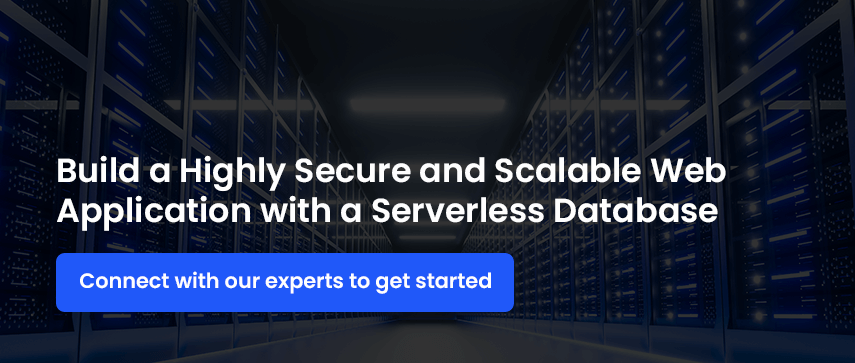Serverless is the future! It is the next-generation approach that lowers the efforts needed to manage and streamline development operations while delivering massive value for business applications. Serverless databases scale automatically based on requests and do not require a lot of capacity planning. In today’s digital age, enterprises need to integrate data reliably into applications that require a secure and highly scalable data infrastructure. This is what serverless databases are trying to solve.

The serverless approach has been adopted worldwide due to its high transparency, faster performance, cost-effectiveness, instant availability, and operating infrastructure support at a large scale. In today’s post, we will talk about modern serverless database solutions that will help you to streamline database deployment and management.
Earlier developers needed specific hardware to process the database when they had to build and deploy applications. It was a time-consuming process because a developer had to wait to receive the server first, followed by the prolonged process of unboxing, installing, cabling, configuring, and deploying applications manually. Traditional database systems launched 20+ years ago require complex sharding and heavy operational management, which ultimately increases costs to develop critical applications.
However, today, the scenario has changed, thanks to the serverless database. Now, developers do not need to go through this lengthy process to maintain the database; they can do the same in just a few minutes securely in a public cloud. So, without further ado, let’s deep dive into the world of the serverless database.
What is Serverless Database?
A serverless database is a cloud-based database service that eliminates the need for infrastructure management, scaling, and provisioning. With serverless databases, developers can focus on building applications or digital products without worrying about managing servers, storage, or backups.
It is designed to manage the unpredictable and rapidly changing workloads of developers. A service provider runs the server and automatically allocates the required resources to developers.
The serverless database platform is scalable and charged based on the requirements, i.e., it is based on the pay-as-you-use model to maintain the database by third-party service providers. They continuously work to meet the fluctuating demand of developers by providing the database-as-a-service.
The ultimate goal of the serverless database is to simplify the management of the database by providing automated scaling and low ops requirements.
With a serverless database, you can avoid issues associated with traditional environments such as cost, security, time, troubleshooting, and maintenance. A Serverless db can be used to develop applications in industries like retail, eCommerce, telecommunications, and finance.
Key Elements of a Serverless Database
To maximize the use of a serverless database, developers must understand the key elements that make it work. Let’s take a look at the same:
-
Automated Elastic Scale
The scalable serverless database meets the unexpected demands of developers worldwide, i.e., it scales down to zero when there’s no demand, and it spins up automatically when any requirement comes in from any region. Some of them are capable of moving data all around the world, enabling users a frictionless experience.
-
Simplicity
The serverless database is simple and easy to use for developers and beginners as well. For them, it is as simple as working with an API. Simplistic features like self-service start and REST APIs with fully manageable operations make the serverless database the first choice for developers to manage and control the app database.
-
Speed of Deployment
The serverless database management system is faster as compared to the traditional system and easy to use. You can create a new cluster of databases in a few minutes. You do not need to spend your time installing, capacity planning, scaling, and configuring your database like a traditional system.
-
Consumption-based Billing
As discussed above, the serverless database is the cost-effective model as it is charged based on consumption, i.e., it follows the pay-as-you-use model. You do not need to pay for storage; you have to pay for the resources you use. You can also set a spending limit in case you look forward to avoiding budget overrun.
Why You Should Use A Serverless Database
Ideally, the serverless database is a great fit for small companies or companies with limited staff members. It requires very little maintenance and infrastructure support with fewer man-hours. Besides, it has other advantages as mentioned below:
-
Cost-effective and High Scalability
With the serverless database, you can save time and avoid operational overhead costs that include license, installation, cabling, configuration, maintenance, and support. Operators or developers do not need to set up scaling computing systems manually. In addition, you can optimally utilize resources based on your requirements to build applications. You do not need to pay more for underutilized resources, just pay for what you use and focus on what matters the most to build high-quality applications.
-
Improved Operations, Scalability, and Performance
Rely on, always available, and easy-to-handle serverless databases to improve your digital product development operations. Instead of hassling efforts related to database management, your developers can use time, memory, or resources efficiently to build, deploy, and maintain applications. Because the database-as-a-service provider is responsible for scaling the capacity to meet your new product development needs. Furthermore, developers or development teams do not need to depend on a separate infrastructure support team. They can focus on coding and run the code independently and deliver applications faster. Adopting the serverless paradigm has enabled developers to shorten the product development life cycle by weeks, offering faster market launches for their products. Highly Secure
Keeping your database secure is important when it comes to rapid application development in today’s digital world. Because applications are more exposed to cyber risks nowadays. And database-as-a-service providers are responsible for securing all the cloud components and OS vulnerabilities. However, serverless brings new security challenges for developers as they are responsible for developing applications by writing application logic, code, data, and security-related layered configurations. When using the serverless database, the platform handles resources, monitors all the running servers, manages OS patches, eliminates any compromised server automatically, and copes with its negative equivalent.

Best 7 Serverless Databases To Use For Your New Project in 2023
Various types of serverless databases are available for developers, such as centralized databases, distributed databases, relational databases, object-oriented databases, non-relational databases, semi-structured and unstructured databases, time-series databases, hierarchical databases, etc.
To develop a great application, you, as an enterprise, should choose the best serverless database as the type of serverless db affects your development life cycle and market launch. So, let’s get started with one of the most popular and highly effective serverless db you can use in 2023 which can accelerate your product development life cycle. Here is the serverless database list:
[A] Relational Serverless Databases
- CockroachDB Serverless
- PlanetScale DB Serverless
- Amazon Aurora Serverless
[B] NoSQL Serverless Databases
- Amazon DynamoDB
- Google FireStore
- Fauna DB
Let’s understand these serverless databases in detail.
[A] Relational Serverless Database
A serverless relational database is a type of database that collects and organizes data based on predefined relationships of key data points. It structures data in such a way that makes it easy for multiple users to find and sort without affecting logical data categorization. It eliminates data deduplication in storage procedures. The application program interface (API) of a relational database is Structured Query Language (SQL)
In this system, data is presented in a tabular form. And this table represents an entity e.g., a product/mobile app. Whereas each row represents the actual value with a unique identifier which is an instance of that type of entity, that’s why it’s called records. On the other hand, the columns hold the attributes of that data, i.e., the actual value attributed to that entity; that’s why they are called attributes. You can access the data without reorganizing the database table.
Relational Serverless Database Examples:
- Standard relational databases include MySQL, Microsoft SQL Server, Oracle Database, and IBM DB2
- Cloud relational databases include Google Cloud SQL, Amazon Relational Database Service, IBM DB2 on Cloud, SQL Azure, and Oracle Cloud
Types of Relational Serverless Databases
1 Cockroachdb Serverless
CockroachDB is the most evolved cloud-based SQL database. It is a fully elastic and resilient data infrastructure distributed worldwide to help developers build applications instantly at a low cost. In many ways, it looks like a single Postgres instance. All the resources are measured in Request Units (RUs), representing the compute used by a query.
Highlight:
- Get started immediately after signing up with your cloud account. You can create a free cluster that takes only 20-30 seconds
- Auto-scale your workload based on application traffic – spike or downtime
- Compatible with the PostgreSQL ecosystem
- Pay for what you utilize and avoid budget overrun
- Avoid downtime like pesky maintenance windows in case of outages
To get started instantly with CockroachDB serverless, you need to first sign up for a CockroachDB cloud account.
2 PlanetScale DB Serverless
The enterprise-ready PlanetScaleDB is a MySQL-compatible serverless database platform powered by Vitess. It is the developer-first database that requires no query planning or cluster size or scaling or any other database-related details in advance. It is compatible with all major frameworks and languages.
Highlights:
- Easy to get started with PlanetScale
- Enterprise-grade scalability
- Development and production branching feature allows you to deploy online schema changes
- Deploy, branch, and query your database directly from the GUI or CLI
- No connection limits for database
- Offers database deployment in limited regions like US East, US West, EU West, Asia Pacific
- Only three ways to authenticate with PlanetScale – email address and password, OAuth via GitHub, and single sign-on
- SOC 2 Type II compliant, encrypts all data at rest and provides configurable authentication and secure user access management.
3 Amazon Aurora Serverless
Amazon Aurora is PostgreSQL and MySQL-based relational database built for the cloud, and Amazon Aurora Serverless is an important configuration for Amazon Aurora. With security, performance, instant availability, and reliability, AWS Aurora Serverless enables you to create a database endpoint immediately in the desired capacity range and connect your applications. You can run your database in the cloud without any hassle of managing data capacity.
Highlights:
- Instantly scales n-number of transactions in friction of seconds
- Chargeable based on your capacity consumption only
- Removes the complexity of managing the database
- Supports Global Database, Multi-AZ deployments, and read replicas
- Automated operations like backups, replicas in the same cluster without disrupting any requests
- Secure migration with minimal downtime
[B] NoSQL Serverless Databases
Not Only SQL (NoSQL) databases are non-relational databases and likely to be distributed more than SQL databases. It is used with a large distributed set of databases. To build cloud-native solutions, enterprises need to take advantage of modern capabilities like serverless NoSQL databases and focus on business outcomes. NoSQL serverless databases are used in real-time web apps. They have simple designs with the capability to handle large volumes of data with zero downtime and are instantly available with horizontal scaling. It is ideally used when the schema is not defined, and high ingestion rates are needed.
Serverless NoSQL databases are popular because they store large volumes of data in various forms like documents, graphs, key/value pairs, and column-oriented data structure, which is easy to understand for developers if they want to change the structure of data.
They are known to handle a tremendous amount of workloads, online transactional processing (OLTP) work, and manage disparate data sets.
Types of NoSQL Serverless Databases:
4 Amazon DynamoDB
A fully managed, key-value NoSQL serverless database service offered by Amazon Web Service (AWS), Amazon DynamoDB requires minimal setup and maintenance to handle massive workloads. DynamoDB is proprietary to AWS, whereas Dynamo is a storage system developed by Amazon.
It is designed to,
- Run high-performance applications at scale and without any hassle of data management
- Deliver apps with faster performance, unlimited storage, and unlimited region replication
- Secure data with encryption at rest
- Scale automatically according to application workload
- Provide capacity modes for each table – on-demand and provisioned
- Lower the efforts related to development and operations
- Speed up the performance of applications
- Create streams of updates to trigger other work in AWS services
- Export data from DynamoDB to Amazon S3 and use other AWS services
5 Google FireStore
Google FireStore is much more than core database tasks for today’s growing serverless computing space as it is a fully manageable, highly scalable, secure, and serverless document database. It enables direct connectivity to the database to accelerate the development of web, IoT, and mobile applications.
Features:
- Highly scalable without maintenance window and zero downtime
- Enables offline data access for Web and mobile SDKs
- Offers more flexibility to structure your data by enabling ACID-compliant transactions
- Supports multiple server-side development libraries and popular programming languages
- Enables data validation and identity-based security access controls
- Real-time data synchronization with offline data access
6 Fauna DB
A developer-friendly, transactional, and first-ever serverless database, FaunaDB is a globally distributed serverless database. It is available on-demand; developers can connect to FaunaDB in seconds. It has driver support for multiple languages like Python, Java, Scala, GraphQL, etc.
Developers do not need to worry about database provisioning, sharding, scaling, replication, or maintenance when enterprises have modernized their OLTP infrastructure using FaunaDB. If you’re developing new microservices or expanding or upgrading your existing applications, FaunaDB is one of the top choices, as it lets you simplify code and speed up the delivery process.
Features:
- Easy to get started, no limits to scale, and no cold start.
- Enables to write User-defined functions with easily accessible business logic
- Web-native security leveraging third-party services like Auth0
- Option to distribute data consistently in selected regions
- 100% ACID-compliant transactions & operation-free system
7 MongoDB Serverless
MongoDB serverless database is a fully managed cloud-based database service. It is designed for workloads with unpredictable traffic patterns or low usage, such as test and development environments or applications with infrequent user access. With MongoDB Serverless, users only pay for the resources they consume, and the service automatically scales resources up and down based on variable demand with minimal configuration and a reliable backend.
By using a MongoDB serverless database, developers can focus on building applications instead of managing infrastructure, which can lead to faster development cycles and more efficient use of resources.
Features:
- Automatically scale resources up and down based on demand
- Supports a range of programming languages, including Java, Python, Node.js, and more.
- Reliable and managed backend
- Faster time to market
- Simplified and flexible database management
- Cost-effective pricing based on actual resource usage
- Dedicated infrastructure clusters with advanced controls
- Advanced security features for data protection
- Versatile and compatible with multiple cloud providers
Conclusion
We have seen the most popular serverless databases with their unique value propositions. Now, enterprises can modernize their data infrastructure by adopting the serverless approach and help developers build high-quality applications without worrying about data maintenance and management.
Today’s enterprises are shifting towards data-driven automated processes that have advanced data management capabilities enabling accelerated software application development and faster market launch. At a broader level, today’s business-critical applications need a data infrastructure that supports automated scalability, faster performance, zero downtime, multiple data models, security, instant availability, and more, which is possible through serverless databases. Connect with our technical experts to get started with a serverless database for your new project in 2023.

Author's Bio:

Pritam Barhate, with an experience of 14+ years in technology, heads Technology Innovation at Mobisoft Infotech. He has a rich experience in design and development. He has been a consultant for a variety of industries and startups. At Mobisoft Infotech, he primarily focuses on technology resources and develops the most advanced solutions.


